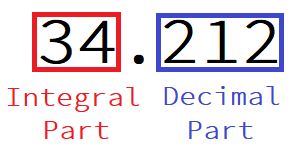How to represent any recurring decimal as a fraction
These topics are covered in the Mathematics syllabus in preparation for the University of Malta MATSEC O level exam. However a strong knowledge of such topics will prove to be extremely important and useful for the workings in the A level topics. These topics are intended as a revision and brush-up for students starting their A level Pure Mathematics in Malta.
What is a decimal number?
A decimal number is a number that has two parts: the integral part and the fractional part. The decimal point separates the integral part (on the left) and the fractional part (on the right). For example, the decimal number 34.212 has 34 as its integral part and 212 as its fractional part.

What is a recurring decimal?
A recurring decimal is a decimal number with an infinite number of digits in the fractional part (i.e. the digits after the decimal point never end) and repeat themselves in a pattern, over and over again.
Examples:
(a) 3.33333…
(b) 0.3232323…
(c) 392.230532567567567….
In Example (a), the digit that is repeating itself is 3. In Example (b), the sequence of digits that is repeating itself is 32. In Example (c), the repeating part does not start immediately after the decimal point, but still, the sequence of digits that is repeating itself is 567.
Representing a recurring decimal with dot notation
In the case where we have just one digit repeating itself, we put a dot above that number. See Example (a) below. In the case where we have more than one digit repeating themselves, we put a dot on the first digit that is repeating itself and another dot on the last digit repeating itself. See Examples (b) and (c) below.
Examples:
(a) 3.33333…=3.\dot{3}
(b) 0.3232323…=0.\dot{3}\dot{2}
(c) 392.230532567567567….=392.230532\dot{5}6\dot{7}
What is the repeating block?
The repeating block of a recurring number is the sequence that is repeating itself and its length is equal to the number of digits present in the block.
Examples:
(a) The repeating block of 3.\dot{3} is 3 and has length 1.
(b) The repeating block of 0.\dot{3}\dot{2} is 32 and has length 2.
(c) The repeating block of 392.230532\dot{5}6\dot{7} is 567 and has length 3.
Representing any recurring decimal as a fraction
This can be done in the following steps:
- Spot the repeating block and calculate its length.
- Let the first equation be: x equals the recurring number.
- Multiply the first equation by 10 if the length of the repeating block is 1; by 100 if the length of the repeating block is 2; by 1000 if the length of the repeating block is 3; etc… This gives you the second equation.
- Deduct the first equation from the second, to obtain the fraction.
Example 1: Represent 3.\dot{3} as a fraction.
Step 1: The repeating block is 3 and this has length 1.
Step 2: x=3.3333…
Step 3: Since the repeating block has length 1, we multiply x by 10. We get: 10x=33.3333…
Step 4:
Example 2: Represent 0.\dot{3}\dot{2} as a fraction.
Step 1: The repeating block is 32 and this has length 2.
Step 2: x=0.3232…
Step 3: Since the repeating block has length 2, we multiply x by 100. We get: 100x=32.3232…
Step 4:
Example 3: Represent 392.230532\dot{5}6\dot{7} as a fraction.
Step 1: The repeating block is 567 and this has length 3.
Step 2: x=392.230563567567…
Step 3: Since the repeating block has length 3, we multiply x by 1000. We get: 1000x=392230.563567567567…
Step 4:
Exercise: Convert the following recurring decimals into fractions:
(a) 0.50505…
(b) 53.4434343…
(c) 10.3597597…
(d) 3.523\dot{4}
(e) 1.5\dot{5}7\dot{2}
(f) -3.\dot{9}
What about decimals with infinite number of digits in the fractional part without a repeating pattern?
It turns out that decimals with infinite number of digits in the fractional part without a repeating pattern CANNOT be expressed as a fraction. In fact such numbers are called irrational number and are described further in the article on Types of Numbers.